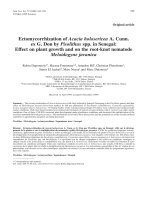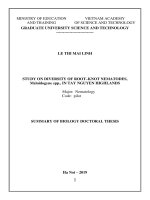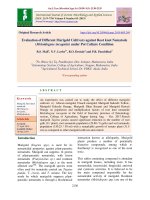Management of root knot nematode (Meloidogyne incognita) in tomato (cv. Pusa ruby) using different oil cakes
Bạn đang xem bản rút gọn của tài liệu. Xem và tải ngay bản đầy đủ của tài liệu tại đây (171.14 KB, 6 trang )
Int.J.Curr.Microbiol.App.Sci (2018) 7(3): 2527-2532
International Journal of Current Microbiology and Applied Sciences
ISSN: 2319-7706 Volume 7 Number 03 (2018)
Journal homepage:
Original Research Article
/>
Management of Root Knot Nematode (Meloidogyne incognita) in Tomato
(cv. Pusa ruby) using Different Oil Cakes
Sasmita Sahu, Mukesh Kumar Patra* and Byomakesh Dash
Department of Nematology, College of Agriculture, OUAT,
Bhubaneswar-751003, Odisha, India
*Corresponding author
ABSTRACT
Keywords
Different oil cakes,
Carbofuran, Chlorophyll,
Meloidogyne incognita,
Solanum lycopersicum
Article Info
Accepted:
20 February 2018
Available Online:
10 March 2018
A replicated pot culture experiment was conducted to study the comparative efficacy of
different oil cakes on management of root knot nematode (Meloidogyne incognita)
infecting tomato. The results revealed that barring the untreated check, all other treatments
significantly increased the plant growth parameters, total chlorophyll content and reduced
root knot nematode population as well as number of galls. Among various treatments, T 8
where neem cake @ 100g/m² and T 7 where mahua cake 100g/m² were applied in pot soil,
resulted plant growth parameters, total chlorophyll content and population growth of root
knot nematode were found statistically at par. Both the aforesaid T 8 and T7 treatments
performing better than others contributed significantly as percentage of increase in plant
height by 85.91% and 73.84%, fresh shoot weight by 60.66% and 55.85%, root length by
89.50% and 78.43%, fresh root weight by 87.04% and 78.98%, total chlorophyll content
by 83.09% and 72.88% with corresponding decrease in order of number of root galls by
78.91% and 68.06% over untreated inoculated check (T 10). Though T7 and T8 exhibited
better results as compared to other treatments and over check (T 10), yet in view of easy
availability and low management option, application of neem oil cake @ 100g/m2 in T8 is
considered the most promising management option against root knot nematode
(Meloidogyne incognita) infecting tomato.
Introduction
Tomato (Solanum lycopersicum L.) belonging
to the family Solanaceae is one of the most
important and nutritive vegetable crop grown
all over the world. India is the second largest
tomato producer and occupies second position
amongst the vegetable crops in terms of
production. Among the major biotic factors
that affect the tomato production, root knot
nematode (Meloidogyne incognita) is the most
serious pest causing considerably low yield in
all parts of India. Root knot nematode causes
an annual loss approximately 27.24% in
tomato in India (Jain et al., 2007). Among
different species of Meloidogyne, M. incognita
is the most widely distributed species on
tomato in Odisha. Management of nematode
problems by applying chemical pesticides
causes serious concern about environment and
human health and also has residual toxicity
which persists for more than 45 days affecting
beneficial
soil
microbes.
Therefore,
incorporation of cultural and use of biocontrol
2527
Int.J.Curr.Microbiol.App.Sci (2018) 7(3): 2527-2532
agents including organic amendments and
botanicals have been regarded to be effective
against nematode infestations. Organic
amendments like oil cakes can provide safe
and pollution free control of plant parasitic
nematodes. Oil cakes change the physical and
chemical properties of the soil which makes
the soil atmosphere unfavorable for nematode
activity and improves soil condition for
greater root growth there by increasing the
utilization of soil nutrients.
T1 – Soil application of Karanja oil cake @
100g/m2
Therefore, an attempt was made to evaluate
the efficacy of certain organic amendments
and carbofuran 3G both individually under
field condition to manage root-knot nematode
problem infecting tomato.
T5 - Soil application of Polango oil cake @
100g/ m2
Materials and Methods
T7 - Soil application of Mahua oil cake @
100g/ m2
Seeds of tomato, cv. Pusa ruby were obtained
from AICRP on Nematodes in cropping
system, OUAT, Bhubaneswar. The seeds were
surface
sterilized
in
2.5%
Sodium
hypochlorite solution for two minutes
followed by rinsing seeds thrice with distilled
water followed by air drying in shade. The
seeds were sown in 30 cm diameter earthen
pots containing steam sterilized soil mixture.
Three such pots were maintained in the net
house. Light watering was done as and when
necessary.
Each of the oil cakes @ 100g/m2 were mixed
thoroughly to the autoclaved soil (1kg) filled
in separate surface sterilized 15cm dia. earthen
pots followed by light watering. All these pots
were maintained as such in the net house for a
period of 7 days for proper decomposition of
oilcakes. A chemical checks with carbofuran
@ 0.3g ai/ m2 was kept for comparison and
mixed with pot soil. An inoculated check was
also maintained. Hence, there were all
together 10 treatments with 3 replications
arranged in Completely Randomized Design
(CRD). The treatments were
T2 - Soil application of Mustard oil cake @
100g/ m2
T3 - Soil application of Jatropha oil cake @
100g/ m2
T4 - Soil application of Groundnut oil cake @
100g/ m2
T6 - Soil application of Kusum oil cake @
100g/ m2
T8 - Soil application of Neem oil cake @
100g/ m2
T9 - Soil application of Carbofuran @ 0.3g a.i.
/ m2
T10 - Untreated inoculated check
Tomato seedlings raised in sterilized soil were
transplanted in the pots (1 in each pot). Fifteen
days old seedlings were used for transplanting
in pot culture experiments. At one week after
transplanting thousand freshly hatched second
stage juvenile of M. incognita were inoculated
to each pot followed by a light watering. This
experiment was terminated after 45 days of
inoculation during which care of each
seedlings and other intercultural operations
were attended regularly.
After 45 days of inoculations, the data of plant
height and root length, fresh shoot and root
weight, number of galls per plant, and also
total chlorophyll content in leaves were
recorded. Various observations recorded from
2528
Int.J.Curr.Microbiol.App.Sci (2018) 7(3): 2527-2532
different treatments and tabular data were
subjected to statistical analysis for each
parameter for comparison of different
treatments following Fisher’s method of
analysis of variance at 5% level.
Results and Discussion
The effect of different oil cakes like karanja,
mustard, jatropha, groundnut, polango, kusum,
mahua and neem were estimated on the basis
of the differential changes in plant growth
parameters (Plant height, fresh and dry shoot
weight) and nematode infection parameter as
number of galls and also total chlorophyll
content in leaves.
The data (Table 1) indicated that there was
progressive increase in plant growth
parameters in respect of plant height, fresh
shoot and root weight in all treatments over
untreated check. Application of neem cake @
100g/m2 resulted maximum increase of plant
growth parameters in comparison to untreated
check where as it was minimum with the
incorporation of mustard oil cake. Neem cake
caused 85.91%, 60.66%, 89.50% and 87.04%
significant increase in plant height, fresh shoot
weight, root length and fresh root weight
respectively. This was followed by Mahua
cake with 73.84%, 55.85%, 78.43% and
78.98% increase over control in the above
parameters. In the contrary, least significant
increase was observed in these parameters
with incorporation of mustard oil cake. This
result corroborates with the findings of Rathar
and Siddiqui (2007) and Kalaiarasan et al.,
(2007) that proved the effectiveness of
oilcakes improving plant growth and reducing
nematode population in tomato. Increased
microbial activity in amended soil is to bring
about increased conversion of nitrogen to
nitrate form, resulted ultimately in increased
metabolic activity of plants and plant growth
(Prasad and Tomar, 2007). This supports the
findings in T8 (neem oil cake @100g/m2)
where there is better growth of tomato plant.
Singh et al., (2009) and Sreenivasan (2010)
applied neem oilcakes and found significant
increase in the plant growth and decrease in
root knot nematode population in green gram
and medicinal coleus respectively. Similar
observation was also reported by Srivastava,
(2002) in papaya.
The results were also in conformity with the
work of Bhattacharya and Goswami, (1989)
who observed that significant increase in plant
growth in crops treated with neem cake
infected by M. incognita. Neem cake at 80
q/ha was found to be more effective than
carbofuran at 2 kg a.i. /ha in reducing rootknot nematode population and enhanced plant
growth on tomato (Jain and Gupta, 1997).
So far as population growth of M. incognita is
concerned, data (Table 2) indicated that there
was decline in number of galls in all treatment
over untreated check. Singh et al., (2009) and
Sreenivasan (2010) also observed similar
results with use of oilcakes. Highest reduction
in galls was noticed in treatment having neem
oil cake (248.33) followed by mahua oil cake
(376) than untreated check (1177.33). Highest
reduction in percentage of galls was noticed in
T8 (78.91%) followed by T7 (68.06%), T6
(61.81%), T9 (52.12%), T5 (41.96%), T4
(38.28%), T1 (29.16%), T2 (16.65%) and T3
(11.13%) over check in descending order. This
finding was agreement with the findings of
Cavoski et al., (2011) and Mehlhom et al.,
(2011). They reported that neem is one of the
most important botanical pesticides which
possess fungicidal, nematicidal, bactericidal
molluscidial, diuretic and antiarthritic
properties. Singh et al., (2012) reported in
chickpea that ammonia, hydrogen sulphide
and phenolic compounds were released
following the decomposition of organic
additives in the soil. These compounds were
found detrimental to the population build-up
of nematodes in vitro.
2529
Int.J.Curr.Microbiol.App.Sci (2018) 7(3): 2527-2532
Table.1 Influence of Meloidogyne incognita in different oilcakes on plant growth parameters of tomato cv. Pusa ruby
Treatments
T1 (Karanja oilcake @ 100g/m²)
T2 (Mustard oilcake @ 100g/m²)
T3 (Jatropha oilcake @ 100g/m²)
T4 (Groundnut oilcake @ 100g/m²)
T5 (Polango oilcake @ 100g/m²)
T6 (Kusum oilake @ 100g/m²)
T7 (Mahua oilcake @ 100g/m²)
T8 (Neem oilcake @ 100g/m²)
T9 (Carbofuran@1kg a.i/ha)
T10 (Untreated check)
S.E. (m)
L.S.D (0.05)
Shoot
Length (cm)
Percentage of
increase
46.74
44.7
41.23
50.63
52.7
62.33
64.27
68.73
56.23
36.97
2.12
6.27
26.43
20.91
11.52
36.95
42.55
68.60
73.84
85.91
52.10
-
Fresh
Shoot
Weight (g)
48.67
46.6
45.17
51.97
52.97
58.5
63.9
65.87
55.83
41
1.72
5.08
Percentage
of
increase
18.71
13.66
10.17
26.76
29.20
42.68
55.85
60.66
36.17
-
Root
length
(cm)
18.13
17.70
17.50
20.53
21.03
26.37
28.37
30.13
23.83
15.90
0.75
2.21
Percentage
of
increase
14.03
11.32
10.06
29.12
32.26
65.85
78.43
89.50
49.87
-
(Average of 3 replications)
Fresh
Percentage
Root
of
Weight (g)
increase
12.77
18.24
12.07
11.76
11.9
10.19
14.1
30.56
15
38.89
17.93
66.02
19.33
78.98
20.2
87.04
16.63
53.98
10.8
0.43
1.27
-
Table.2 Effects of oil cake on number of galls in roots and chlorophyll content of leaves in tomato cv. Pusa ruby infected by
Meloidogyne incognita
Treatments
No. of Galls
834 (2.92)*
T1 (Karanja oilcake @ 100g/m²)
981.33 (2.99)
T2 (Mustard oilcake @ 100g/m²)
1046.33 (3.02)
T3 (Jatropha oilcake @ 100g/m²)
726.67 (2.86)
T4 (Groundnut oilcake @ 100g/m²)
683.33 (2.83)
T5 (Polango oilcake @ 100g/m²)
449.67 (2.65)
T6 (Kusumoilake @ 100g/m²)
376 (2.57)
T7 (Mahua oilcake @ 100g/m²)
248.33 (2.37)
T8 (Neem oilcake @ 100g/m²)
563.67 (2.75)
T9 (Carbofuran@1kg a.i/ha)
1177.33 (3.07)
T10 (Untreated check)
S.E. (m)
0.048
L.S.D (0.05)
0.14
*Figures in parentheses indicate log transformed values
Percentage of
decrease
29.16
16.65
11.13
38.28
41.96
61.81
68.06
78.91
52.12
-
2530
(Average of 3 replications)
Total Chlorophyll content (mg/g) Percentage of increase
1.55
1.54
1.47
1.66
1.73
1.83
1.92
1.99
1.82
1.09
0.03
0.08
42.20
41.28
34.86
52.29
58.72
67.89
76.15
82.57
66.97
-
Int.J.Curr.Microbiol.App.Sci (2018) 7(3): 2527-2532
With regards to data (Table 2), it was noticed
that application of oilcakes significantly
increased the chlorophyll content in leaves of
tomato plant. Neem cake treatment effectively
increased the chlorophyll content by 73.1 %
followed by mahua cake (64.1%) as compared
to the untreated one. Similarly, mustard oil
cake was least effective in increasing the
chlorophyll content of the leaves as compared
to all other treatments. Siddiqui and Akhtar
(2008) observed that the increase in
chlorophyll contents in leaves in the presence
of decomposed organic wastes is due to
increase in N uptake by the addition of
organic compounds resulted in increased
photosynthetic efficiency, translocation of
nutrients, and other metabolites toward
formation of fruits. Similarly, Oka et al.,
(2007) reported that nitrogen content in form
of ammonium present in organic amendments
which is more harmful to nematodes.
To conclude with the present investigation, it
was evident that the application of neem oil
cake @ 100g/m² and mahua oil cake @
100g/m² provided better for management but
in view of easy availability and low
management option, application of neem oil
cake @ 100g/m2 in T8 is considered the most
promising management option against root
knot nematode (Meloidogyne incognita)
infecting tomato. However, it is worthwhile to
study the efficacy of the treatment in the field
condition for more meaningful result in
managing root-knot nematode.
References
Bhattacharya, D., and Goswami, B.K. 1987a.
A study on the comparative efficacy of
neem and ground nut oil cakes against
root-knot
nematode,
Melodogyne
incognita
as
influenced
by
microorganisms on sterilized and
unsterilized soil, Indian Journal of
Nematology, 17: 81-83.
Cavoski, I., Caboni, P., and Miano, T. 2011.
Natural
pesticides
and
future
perspectives. In: Margarita Stoytcheva
ed. Pesticides in the modern world pesticides use and management. InTech
open science. Pp 169-190.
Jain, R.K., and Gupta, D.C. 1997. Efficacy of
neem (Azadirachta indica) cake as
nursery bed treatment
in
the
management of root knot nematode
(Meloidogyne
javanica)
infecting
tomato, Indian Journal of Nematology,
27(2): 249-252.
Jain, R.K., Mathur, K.N. and Singh, R.V.
2007. Estimation of losses due to plant
parasitic nematodes on different crops
in India, Indian Journal of Nematology,
37(2):219-221.
Kalaiarasan, P., Senthamarai, M., Ramesh, D.
and Sudheer, M.J. 2007. Jatropha: An
efficient organic amendment for the
management of root-knot nematode,
Meloidogyne incognita in tomato,
Indian Journal of Nematology, 37(2):
115-118.
Mehlhom, H., Al-Rasheid, K.A.S., and
Abdel-Ghaffar F. 2011. The neem tree
story: Extracts that really work. In: H.
Mehlhom
(Ed.)
Nature
helps,
parasitology research (Monographs 1),
Springer-Verlag, Berlin. Pp 77-108.
Oka, Y., Tkachi, N., Shuker, S., and
Yerumiyahu, U. 2007. Enhanced
nematicidal activity of organic and
inorganic
ammonia
releasing
amendments by Azadirachta indica
extracts, Journal of Nematology, 39(1):
9-16.
Prasad, D., and Tomar, S.S. 2007. Toxicity of
plant extracts against root knot and
reniform nematodes, Annals of Plant
Protection Science, 15: 535-537.
Rather, M.A. and Siddiqui, M.A. 2007. Neem
for the control of root-knot nematode
infecting tomato, Indian Journal of
Nematology, 37(1): 81-110.
2531
Int.J.Curr.Microbiol.App.Sci (2018) 7(3): 2527-2532
Siddiqui, Z.A., and Akhtar, M.S. 2008.
Arbuscular mycorrhizal fungi as
potential biprotectants against plant
pathogens. In Z. A. Siddiqui, M. S.
Akhtar, & K. Futai (Eds.), Mycorrhizae:
Sustainable agriculture and forestry.
Pp. 61–97.
Singh, K.S., Azam, M.F., Gurjar, M.S., and
Shahid, A. 2012. Effect of plant extracts
against Meloidogyne incognita on chick
pea, Annals of Plant Protection Science,
20(2): 449-451.
Singh, S., Kumar, S., and Verma, R.A. 2009.
Management of Meloidogyne incognita
through organic amendments on green
gram, Annals of Plant Protection
Science, 17(1): 185-187.
Sreenivasan, N. 2010. Management of rootknot nematode, Meloidogyne incognita
with organic amendments in medicinal
coleus, Annals of Plant Protection
Science, 18(2): 472-476.
Srivastava, S.S. 2002. Efficacy of organic
amendments in the management of root
knot nematode (Meloidogyne incognita)
infecting papaya, Indian Journal of
Nematology, 32(2): 183-185.
How to cite this article:
Sasmita Sahu, Mukesh Kumar Patra and Byomakesh Dash. 2018. Management of Root Knot
Nematode (Meloidogyne incognita) in Tomato (cv. Pusa ruby) using Different Oil Cakes.
Int.J.Curr.Microbiol.App.Sci. 7(03): 2527-2532. doi: />
2532









